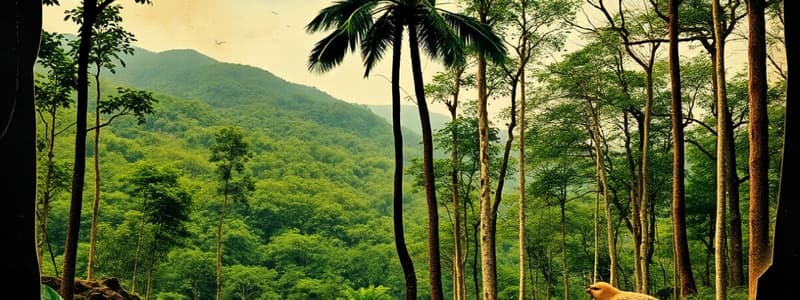Podcast
Questions and Answers
Which of the following best illustrates the interdependence of biotic and abiotic characteristics in the tropical rainforest?
Which of the following best illustrates the interdependence of biotic and abiotic characteristics in the tropical rainforest?
- Drip tips on leaves facilitate water runoff, preventing fungal growth in the humid equatorial climate. (correct)
- The thick bark of rainforest trees protects them from animal herbivory.
- The bright coloration of rainforest frogs warns predators of their toxicity.
- Epiphytes growing on tree branches compete with the trees for sunlight.
The taiga biome's high productivity and active nutrient cycling result in biodiversity levels surpassing those of the tropical rainforest.
The taiga biome's high productivity and active nutrient cycling result in biodiversity levels surpassing those of the tropical rainforest.
False (B)
Explain how the demand for biofuels, mineral resources, and hydroelectric power (HEP) can collectively contribute to deforestation in tropical rainforests.
Explain how the demand for biofuels, mineral resources, and hydroelectric power (HEP) can collectively contribute to deforestation in tropical rainforests.
Biofuel crops require land cleared from forests; mining operations necessitate deforestation for access and infrastructure; HEP projects involve flooding forested areas for reservoirs.
The exploitation of minerals and fossil fuels in the taiga poses ______ threats to the biome due to habitat destruction and pollution.
The exploitation of minerals and fossil fuels in the taiga poses ______ threats to the biome due to habitat destruction and pollution.
Match each threat to the Taiga with its corresponding consequence:
Match each threat to the Taiga with its corresponding consequence:
Which statement accurately contrasts the characteristics of plants in the tropical rainforest and the taiga?
Which statement accurately contrasts the characteristics of plants in the tropical rainforest and the taiga?
CITES (Convention on International Trade in Endangered Species) is universally successful in eliminating illegal logging and trade of endangered rainforest species across all regions.
CITES (Convention on International Trade in Endangered Species) is universally successful in eliminating illegal logging and trade of endangered rainforest species across all regions.
Explain how climate change acts as an indirect threat to the health and biodiversity of tropical rainforests.
Explain how climate change acts as an indirect threat to the health and biodiversity of tropical rainforests.
Unlike tropical rainforests, the taiga exhibits a significantly ______ active nutrient cycle due to the cold climate and slow decomposition rates.
Unlike tropical rainforests, the taiga exhibits a significantly ______ active nutrient cycle due to the cold climate and slow decomposition rates.
Which of the following accurately compares the adaptation strategies of animals in the tropical rainforest and the taiga?
Which of the following accurately compares the adaptation strategies of animals in the tropical rainforest and the taiga?
Flashcards
Ecology
Ecology
The study of the interrelationships between living organisms and their environment
Ecosystem
Ecosystem
A community of living organisms (biotic) interacting with each other and their non-living (abiotic) environment.
Abiotic factors
Abiotic factors
Non-living components of an ecosystem like climate, soil, and water.
Biotic factors
Biotic factors
Signup and view all the flashcards
Ecosystem Resilience
Ecosystem Resilience
Signup and view all the flashcards
Nutrient cycling
Nutrient cycling
Signup and view all the flashcards
Deforestation
Deforestation
Signup and view all the flashcards
Sustainable Management
Sustainable Management
Signup and view all the flashcards
Climate Change (Rainforests)
Climate Change (Rainforests)
Signup and view all the flashcards
Buttress Roots
Buttress Roots
Signup and view all the flashcards
Study Notes
- Forests are under threat.
Tropical Rainforests
- The structure, functioning, and adaptations of tropical rainforests reflect the equatorial climate.
- Biotic and abiotic characteristics are interdependent (climate, soil, water, plants, animals, and humans).
- Plants have stratified layers, buttress roots, and drip tips, and animals are adapted to the climate.
- Tropical rainforests have a very high rate of nutrient cycling, supporting high levels of biodiversity and complex food webs.
Taiga
- The taiga exhibits different characteristics, reflecting the more extreme and highly seasonal climate.
- Biotic and abiotic characteristics are interdependent (climate, soil, water, plants, and humans).
- Taiga plants (cone-shaped, needles, simple structure) and migratory animals are adapted to the climate.
- The taiga has lower productivity due to less active nutrient cycling and much lower levels of biodiversity.
Threats to Tropical Rainforests
- Tropical rainforests are directly endangered by deforestation and indirectly by climate change.
- Deforestation is caused by commercial hardwood logging, subsistence and commercial agriculture, local demand for fuel wood, demand for biofuels, mineral resources, and electricity (HEP).
- Climate change indirectly threatens the health of tropical rainforests through ecosystem stress and drought.
Threats to the Taiga
- The taiga is increasingly threatened by commercial development.
- Direct threats include logging for softwood, pulp, and paper production.
- Indirect threats result from the exploitation of minerals, fossil fuels, and HEP potential.
- Acid precipitation, forest fires, pests, diseases, and also contribute to a loss of biodiversity.
Conservation
- The conservation and sustainable management of tropical rainforests is vital for future generations.
- Global actions (CITES, REDD) are designed to protect tropical rainforest species and areas.
- Deforestation rates are increasing in some areas but falling in others.
Studying That Suits You
Use AI to generate personalized quizzes and flashcards to suit your learning preferences.




